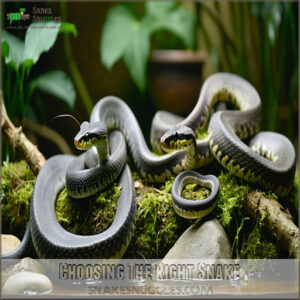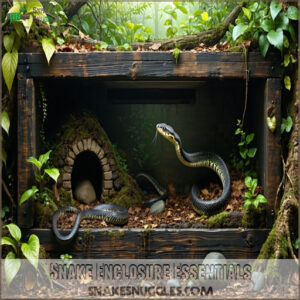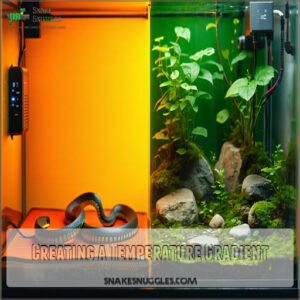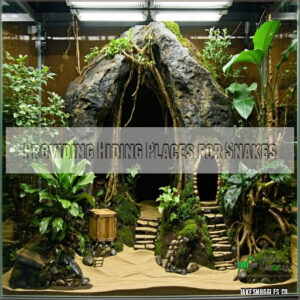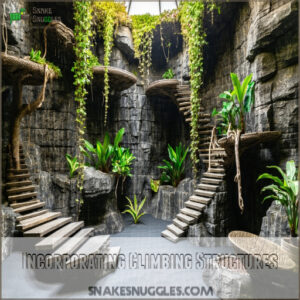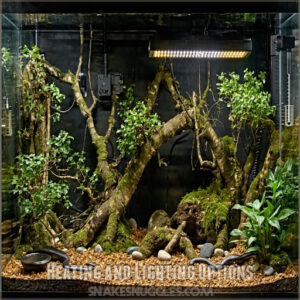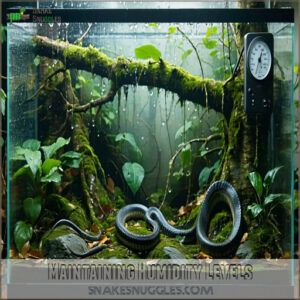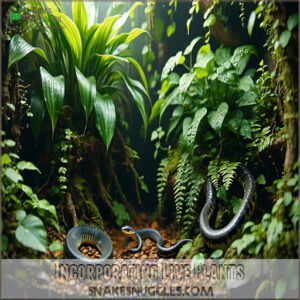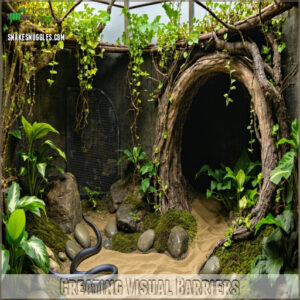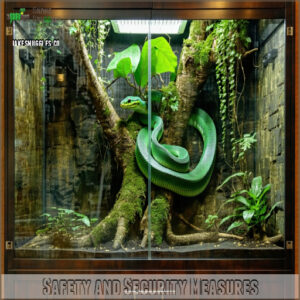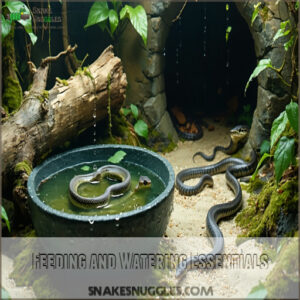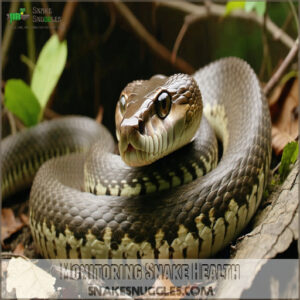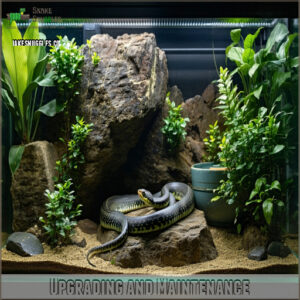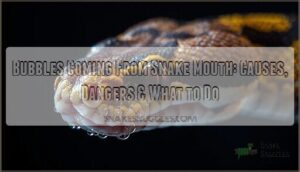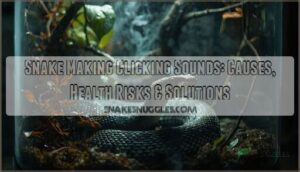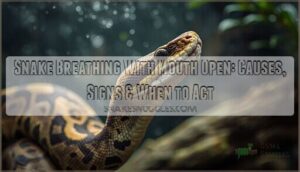This site is supported by our readers. We may earn a commission, at no cost to you, if you purchase through links.
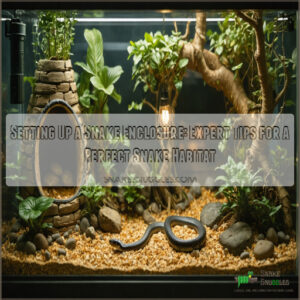
When setting up a snake enclosure, create a temperature gradient using a heat mat or lamp – think of it as your snake’s personal climate control system.
Add a substrate that matches their natural habitat, and include hiding spots and climbing structures to keep your serpentine friend active and healthy.
Install a reliable thermostat to maintain ideal temperatures, and don’t forget about humidity control.
Just like we need different rooms for different activities, your snake needs various zones for thermoregulation and enrichment.
Table Of Contents
- Key Takeaways
- Choosing The Right Snake
- Snake Enclosure Essentials
- Setting Up The Enclosure
- Heating and Lighting Options
- Maintaining Humidity Levels
- Creating a Naturalistic Environment
- Safety and Security Measures
- Feeding and Watering Essentials
- Monitoring Snake Health
- Upgrading and Maintenance
- Frequently Asked Questions (FAQs)
- How do I set up a snake enclosure?
- Where can I buy a snake enclosure?
- How do I choose a pet snake enclosure?
- Do snakes need a new enclosure?
- How big should a snake enclosure be?
- How to maintain a snake’s enclosure?
- How should a snake tank be set up?
- What do you put in the bottom of a snake cage?
- How do you set up a snake cage?
- What is needed in a snake enclosure?
- Conclusion
Key Takeaways
- You’ll need an enclosure at least twice your snake’s length with proper ventilation, secure locks, and a substrate that matches their natural habitat – this ensures they have enough space to move and feel secure.
- Create a temperature gradient using a heat mat or lamp (80-90°F warm side, 75-80°F cool side) with a reliable thermostat to maintain ideal temperatures and support proper thermoregulation.
- Set up multiple hiding spots across temperature zones and include climbing structures for enrichment – this lets your snake regulate its temperature while feeling secure and staying active.
- You’ll need to monitor humidity levels daily with a hygrometer, use humidity-retaining substrates, and implement a misting system to maintain proper moisture levels for healthy shedding and overall wellbeing.
Choosing The Right Snake
Choosing the right snake is one of the most important steps in setting up a proper enclosure.
Consider the species’ size, temperament, and care requirements to make sure it fits your experience level and home environment, focusing on complete concepts to ensure a suitable match.
Spotted Pythons Characteristics
Spotted Pythons are perfect beginner pets due to their gentle temperament and manageable size, reaching just 3-4 feet.
They thrive with proper python care and basic reptile enclosure setup. These snakes adapt easily and don’t demand massive setups.
To keep them healthy:
- Provide a secure snake enclosure size (twice their length).
- Maintain a proper snake diet.
- Maintain stable temperatures.
- Add hiding spots for comfort.
- Monitor reptile health regularly.
Childrens Pythons Characteristics
Children’s Pythons stand out for their gentle nature, slender build, and manageable Python size, reaching about three feet when fully grown.
Their calm Snake behavior makes them ideal for beginners, thriving in a well-designed snake tank setup.
Native to Australia’s rocky terrains, they adapt well to various reptile enclosure setups with proper Python care.
Their feeding habits are straightforward, and they’re low-maintenance.
With a lifespan of up to 30 years, they’re a rewarding choice for any terrarium setup.
To create an ideal environment, you must research their natural habitat needs to guarantee a healthy and thriving pet.
Snake Enclosure Essentials
To create a healthy and secure home for your snake, focus on selecting the right size enclosure and ensuring proper ventilation.
Add suitable substrate, hides, and enrichment to provide comfort, mimic natural conditions, and support overall well-being.
Terrarium Selection and Size
Choosing the right terrarium size is essential for a happy, healthy snake.
Your snake enclosure needs to be spacious enough for the snake to stretch fully, slither comfortably, and grow. When making a terrarium selection, prioritize a tank size that’s at least as long as the snake, with sufficient enclosure depth and optional vertical space for arboreal species.
While glass enclosures look great, custom builds offer flexibility for customized needs. Make sure your vivarium setup includes proper ventilation and sturdy materials for safety.
Determining the ideal snake terrarium size requires considering factors such as optimal terrarium dimensions to create a suitable environment.
Substrate Options for Snakes
Every snake’s home starts with the right reptile substrate. Let’s break it down:
- Aspen shavings: Cheap and ideal for low humidity, but moldy when wet.
- Eco Earth substrate: Retains moisture, great for tropical species.
- Sand mix with Eco Earth: Perfect for burrowers while holding humidity.
Add cork bark or blend in a Pothos plant for natural, bioactive setups.
Always choose substrate materials that match your snake’s humidity and safety needs! When selecting a substrate, consider avoiding harmful snake substrates to make sure a safe environment.
Providing Enrichment for Snakes
A snake’s habitat isn’t just about size—it’s about making it interesting! Enrichment promotes natural behaviors and keeps your snake mentally stimulated.
Use a variety of items to create a snake-friendly environment:
- Snake Toys like tunnels or balls offer sensory experiences.
- Climbing structures mimic nature, sparking behavioral triggers.
- Hiding spots provide comfort and activity zones.
- Rearrange decor occasionally for environmental stimulation.
Follow a snake enrichment guide to guarantee a healthy, engaging setup.
Setting Up The Enclosure
When setting up a snake enclosure, you’ll focus on creating a safe and comfortable space that mimics your snake’s natural habitat.
Proper heating, hides, and climbing structures are essential to meet their physical and behavioral needs.
Creating a Temperature Gradient
To keep your snake comfortable, use a heat mat or other heat sources to create a proper temperature gradient.
Set one side warm (80–90°F) and the other cooler (75–80°F). A thermostat guarantees accurate temperature control, preventing overheating.
Check the setup daily using thermometers. Think of it as setting up cozy temperature zones for your scaled friend.
| Hot Zone (°F) | Cool Zone (°F) | Equipment Needed |
|---|---|---|
| 85–90 | 75–80 | Heat mat, thermostat |
| 88–92 (basking) | N/A | Heat lamp |
| 80–85 | 75–78 | Thermometers |
Providing Hiding Places for Snakes
Providing hiding places is critical for your snake’s comfort and well-being.
A mix of natural hides, DIY hides, and commercial hides works best. Rock caves, plant covers, and log hides offer variety and security.
Place them strategically across the terrarium to mimic their natural habitat. Snakes feel secure with multiple cozy options!
- Natural hides: Cork bark or hollow logs.
- DIY hides: Modified sturdy boxes.
- Commercial hides: Store-bought caves or shelters.
Incorporating Climbing Structures
Adding climbing structures transforms your snake enclosure, enhancing its design and your pet’s lifestyle.
Use climbing ramps, driftwood, or textured rock walls for vertical space. Place climbing branches securely, ensuring they’re sturdy and complement the tank’s size.
Incorporate texture variety for grip and exploration. Vertical snake tank ideas, like hanging vines or staggered platforms, add enrichment while encouraging natural behavior.
Your snake will appreciate the challenge!
Heating and Lighting Options
Proper heating and lighting are essential to create a comfortable and healthy environment for your snake.
By selecting the right equipment and maintaining a consistent day-night cycle, you’ll mimic natural conditions and support their well-being.
Choosing The Right Heat Source
Keeping your snake warm starts with the right heat source.
Heat mats work for smaller enclosures, while larger setups benefit from ceramic or infrared heat lamps.
A thermostat maintains safe, consistent temperature control, preventing overheating.
Snakes need a temperature gradient—a warm side for thermoregulation, reaching 88-92°F, and a cooler side around 75-82°F.
Use reptile-friendly thermometers to spot-check temps.
Always match heating elements to your snake’s size and species.
Proper heat makes for a healthy, happy snake in its new home!
When setting up the enclosure, consider the importance of a snake heat lamp for maintaining ideal temperatures.
Installing Proper Lighting Systems
Now that your heat source is set, let’s focus on lighting systems.
Use LED lighting for energy efficiency and balanced illumination. UVB systems aren’t always required but can enhance your snake’s environment.
Place heat lamps safely using a lighting hood to avoid burns. Install thermostat controls to monitor bulb intensity.
Regularly check your reptile lighting for even coverage and replace expired bulbs promptly for effective health and safety.
Creating a Day-Night Cycle
A consistent day-night cycle is essential for your snake’s circadian rhythms and overall health.
Use timers to automate lighting schedules, ensuring 12-hour light-dark periods. Aligning your lighting with natural photoperiod management supports their natural behaviors.
Avoid abrupt temperature fluctuations by pairing heat mats or ceramic heaters with thermostats for a controlled temperature gradient even after lights out.
Balanced lighting systems additionally mimic seasonal shifts but also aid in humidity control. Photoperiod control creates stable environmental conditions, reducing stress.
A well-ventilated enclosure further prevents moisture buildup, protecting against harmful bacteria while crafting a safe, cozy habitat your snake will thrive in.
Maintaining Humidity Levels
Keeping the proper humidity levels in a snake enclosure is essential for their health and shedding.
You’ll need to monitor conditions with a hygrometer and adjust using misting or humidity-retaining substrates.
Incorporating Misting Systems
Maintaining proper humidity levels is key to creating a healthy environment for your snake.
Automated misting systems and spray systems are a simple way to achieve reliable mist control. These systems help maintain humidity levels between 55-75%, with short spikes up to 85% during shedding periods.
Fogging systems or water misters can mimic a natural habitat, distributing moisture evenly and ensuring consistent water cycling. Position misting nozzles strategically to avoid pooling water.
Using a programmable timer, you can automate humidity control, reducing manual effort and human error. Regularly monitor conditions with a hygrometer to tweak settings as needed, keeping your snake’s enclosure balanced and safe for daily comfort.
Using Humidity-Retaining Substrates
Humidity control becomes effortless with the right substrate.
Consider these options:
- Coconut husk: Great for moisture levels and humidity, offering a bioactive substrate feel.
- Eco Earth: Expands with water, pairs well with sand mixtures, and works wonders in bioactive setups.
- Aspen shavings: Budget-friendly but less humidity-retaining.
Pair these with misting systems to keep your enclosure thriving.
Monitoring Humidity Levels
You’ve chosen humidity-retaining substrates. Now, it’s time to track humidity levels with a hygrometer—your enclosure’s compass for humidity control.
Maintain daily checks to keep conditions within the ideal range for your snake. Combine this with misting systems, water bowls, and humid hideboxes for balance. Ensure proper ventilation to prevent mold growth.
A simple log can help you monitor changes over time for consistent care. Understanding humidity control methods is key to creating a healthy environment.
| Tool | Purpose | Placement |
|---|---|---|
| Hygrometer | Measures humidity | Mid-height inside |
| Water Bowl | Adds humidity | Cool side |
| Humid Hide | Retains moisture | Warm side |
| Misting | Raises humidity fast | Across |
Creating a Naturalistic Environment
Creating a naturalistic environment helps your snake feel secure and promotes natural behaviors.
By adding features like live plants, textured surfaces, and visual barriers, you can mimic their native habitat effectively.
Adding Decorations and Enrichment
Once your snake’s space is humid enough, amp it up with enriching touches.
Add climbing structures for exploration, snake enclosure decor like natural hides, and snake toys to inspire curiosity. Use visual barriers for privacy, or try enrichment activities like textured surfaces.
Creating a naturalistic environment is essential for the well-being of your snake.
Here are ideas:
- Rock caves for hiding.
- Snake-friendly plants.
- Natural wood perches.
- Enrichment toys.
- Logs for climbing.
Incorporating Live Plants
Live plants offer beauty and functionality for your snake enclosure. Focus on snake-safe plants like pothos and ferns. Use organic, pesticide-free soil and make sure proper drainage. Place plants securely to avoid disruption.
Regular pruning prevents overgrowth, while watering systems maintain balance. Toxicity checks protect your snake, ensuring a lush, safe space.
- Choose sturdy snakesafe plants
- Make sure proper soil choice
- Set up balanced watering systems
- Regularly use pruning techniques
- Conduct frequent toxicity checks
Creating Visual Barriers
Adding visual barriers to your snake’s enclosure is like giving it a private retreat.
Use Plant Placement, Visual Hides, or strategically arranged Decor Options to create cozy, hidden corners.
Materials like bark, vines, or screens mimic a snake’s natural habitat, making them feel secure.
Combine Barrier Materials with climbing structures or layered hiding spots for extra comfort.
Clever Screening Ideas also block unwanted visibility, reducing stress.
These enhancements don’t just promote security—they turn your enclosure into the perfect snake sanctuary!
Safety and Security Measures
Keeping your snake safe starts with installing secure lids and locks that prevent escapes. Seal gaps and consider a double-door system to guarantee your snake stays where it belongs.
Installing Escape-Proof Lids and Locks
Keeping your snake contained starts with escape-proof lids and reliable locking mechanisms.
Use secure lids crafted from durable lid materials like glass or plastic with tight-fitting clamps. Reinforce escape prevention by testing locking systems regularly.
Install dependable locks that resist tampering, ensuring no sneaky escapes. Always double-check lid security after access.
A secure enclosure guarantees your snake’s safety and your peace of mind.
Sealing Potential Escape Routes
Snakes are born escape artists—don’t let them outsmart you! Strengthen your escapeproof enclosure by using proper sealant options to close gaps around corners and edges.
Inspect ventilation gaps and reinforce them with escapeproof materials. Secure lids with strong locking mechanisms to keep things tight. Watch for wear and tear over time.
- Check for loose seams daily.
- Seal cracks using silicone or epoxy.
- Add weatherstripping to frame edges.
- Reinforce ventilation gaps firmly.
Implementing Double-Door Entry Systems
To keep snakes safely contained, double-door entry systems are a smart solution.
They act as a backup barrier, reducing escape chances during cleaning feeding.
Think of it as a secure lockbox for your snake’s habitat.
Here’s a quick breakdown:
| Feature | Benefit |
|---|---|
| Secure Lids | Prevent accidental openings |
| Double Doors | Two layers of protection |
| Locking Mechanisms | Ensure escape-proof security |
These systems add peace of mind, especially for active snakes.
Pair them with escape-proof lids and sturdy locking mechanisms for the ultimate safety net.
Feeding and Watering Essentials
Providing the right food and fresh water keeps your snake healthy and well-nourished. Stick to appropriately sized prey and clean the water bowl daily to prevent bacteria buildup.
Choosing The Right Food for Your Snake
A proper snake diet is essential for their health.
Meeting their dietary needs includes ensuring prey items match your snake’s size and preferences.
To simplify, here’s what you should focus on:
- Prey Size: Match prey to the snake’s thickest body part.
- Food Types: Frozen/thawed mice or rats are safest.
- Feeding Schedule: Adults eat every 7-14 days.
- Live Prey Feeding: Use cautiously to avoid injuries.
Balanced nutrition keeps snake health issues at bay.
Providing Fresh Water
Choose a stable, easy-to-clean water bowl for your snake’s comfort.
Replace water daily to maintain superior water quality. Using filtered water reduces contaminants, acting like a mini spa for your pet.
Keep the dish in a quiet spot to avoid stress. Proper snake habitat essentials, such as temperature gradients, are essential for creating a healthy environment.
| Aspect | Tip | Benefit |
|---|---|---|
| Bowl Size | Stable and spacious | Comfort and prevent tipping |
| Water Quality | Use filtered water | Avoids contaminants |
| Fresh Supply | Change daily | Maintains hydration |
| Placement | Quiet location | Reduces stress |
| Maintenance | Clean regularly | Stops bacteria growth |
Managing Food Storage and Handling
Food safety begins with smart storage and handling of your snake’s meals. Designate a dedicated freezer space for storing pre-killed prey, maintaining a consistent -4°F temperature for ideal preservation.
- Label containers with purchase dates and rotate stock every 3-4 months.
- Thaw prey items in sealed bags within the refrigerator, never at room temperature.
- Use dedicated feeding tongs and maintain a separate feeding area.
Monitoring Snake Health
You’ll need to monitor your snake’s health regularly by checking for signs like clear eyes, smooth skin, and normal breathing patterns.
With proper monitoring and quick action when issues arise, you can assure your snake stays healthy and active in its carefully designed habitat.
Recognizing Signs of Stress or Illness
Watching for stress signs in your snake is similar to monitoring a child’s wellbeing.
Your snake’s behavior tells a story – sudden changes like frequent escape attempts or unusual hiding patterns often signal distress.
Notice if your pet becomes overly alert or shows aggressive displays like hissing or mock strikes.
Physical symptoms including respiratory issues, muscle control problems, or loss of appetite require immediate attention.
Regular health checks help catch issues early.
If you spot lethargy combined with hiding or constant soaking in the water dish, it’s time for a veterinary visit to address potential respiratory issues.
Implementing Quarantine Procedures
Quarantine protocols protect your snake family from unwanted surprises.
You’ll need a dedicated space for 3-6 months when introducing new serpents. During this time, follow strict isolation tips and maintain separate handling equipment for each snake.
- A clean, minimalist quarantine bin with basic necessities
- Fresh paper towels as substrate for easy health monitoring
- Separate feeding tongs and water dishes
- Disposable gloves and face masks nearby
- A dedicated cleaning kit with animal-safe disinfectant
This setup is crucial for the health and safety of your snake family, ensuring that you can monitor their condition closely and prevent any potential health risks.
Providing Appropriate Shedding Environments
Creating the perfect shedding environment helps your snake molt smoothly and stay healthy.
Your snake will show environmental cues like dull skin and cloudy eyes when ready to shed.
Set up moisture-rich zones with humidity levels between 50-60% for ideal skin health.
- Place rough-textured items like cork bark for natural shedding assistance
- Install a humidity gauge to monitor moisture levels accurately
- Create a special humid hide box filled with damp moss
- Check ventilation to prevent excess moisture buildup
- Remove old shed skin promptly to maintain enclosure cleanliness
This reorganization improves readability by grouping related concepts and ideas together, making it easier to follow the instructions for creating an ideal environment for a snake to shed.
Upgrading and Maintenance
You’ll need to upgrade your snake’s enclosure as it grows, ensuring the space matches its increasing size and activity needs.
Regular maintenance includes adapting heating systems, renovating enrichment features, and keeping the habitat clean to support your snake’s health and comfort.
Assessing Space Requirements as Snakes Mature
Your snake’s enclosure size directly impacts its health and happiness.
Just like humans need more living space as they grow, your snake requires space planning to match its increasing size.
A good rule of thumb: your snake enclosure size should be at least twice the length of your pet when fully stretched out.
Start with a minimum tank size requirement that’s three-quarters the snake’s length in width and one-third in height.
For most species, a 40-gallon tank works well for juveniles, but you’ll need to plan ahead for mature habitat needs.
Watch for signs that your snake needs more room—difficulty turning around, frequent escape attempts, or restless behavior.
Consider your snake’s scaling needs early on to avoid rushed enclosure upgrades later.
Your growing companion will thank you with healthy, active behavior.
Adapting Heating and Lighting for Larger Enclosures
As your enclosure grows, you’ll need to adapt your temperature control strategy.
Install multiple heat sources strategically – combine a heat mat for belly warmth with overhead lighting systems.
Create consistent thermal gradients by positioning UVB systems and heat lamps across the space.
Monitor temperatures at different heights and adjust accordingly.
For best results, integrate a combination of lighting options while maintaining proper spacing between heat sources.
Effective snake enclosure heating systems require understanding temperature control methods to maintain a healthy environment with proper thermal gradients and temperature control.
Incorporating More Complex Enrichment Features
Transform your snake’s space with enrichment features that spark natural behaviors.
Add diverse textures like cork bark, climbing structures, and varied hides to create a stimulating environment.
Incorporate vertical space using sturdy branches and ledges for exploration.
Mix up sensory experiences with different substrates and environmental enrichment tools.
Your snake’s naturalistic environment will encourage activity while supporting their instinctive needs.
Frequently Asked Questions (FAQs)
How do I set up a snake enclosure?
You’ll need a spacious tank with proper ventilation, heating pad, substrate, and two hiding spots.
Add a water bowl, maintain correct temperature gradients, and monitor humidity levels for your snake’s comfort.
Where can I buy a snake enclosure?
You’ll find quality snake enclosures at pet stores like PetSmart or Reptile-specific shops.
Check online marketplaces such as Amazon, Chewy, or specialty retailers for wider selections and competitive prices.
Local breeders often sell terrariums too, which can be a good option to find quality snake enclosures.
How do I choose a pet snake enclosure?
Select an enclosure that’s twice your snake’s length, with proper ventilation and secure locks.
You’ll want space for hiding spots, a water bowl, and temperature control systems to keep your pet comfortable.
Do snakes need a new enclosure?
Like a growing child outgrowing clothes, your snake will require a larger home as it grows.
You’ll need to upgrade the enclosure to maintain comfort, ensuring it’s at least twice your snake’s length, which is a complete concept to consider for your snake’s well-being.
How big should a snake enclosure be?
Your snake’s enclosure should measure at least twice its body length. You’ll want a minimum 40-gallon tank that provides enough space for stretching, climbing, and creating temperature zones they’ll need.
How to maintain a snake’s enclosure?
Clean and check your enclosure daily, replace water, monitor temperatures, and remove waste.
You’ll need to deep clean weekly, replace substrate monthly, and verify humidity levels stay consistent for ideal snake health.
How should a snake tank be set up?
You’ll need an enclosure twice your snake’s length with proper ventilation. Add substrate, heating pad, thermometer, two hides, climbing branches, and a water bowl. Maintain 80-85°F warm side temperature.
What do you put in the bottom of a snake cage?
Your slithering companion’s comfort starts with the right substrate.
You’ll want to use aspen shavings, coconut husk, or cypress mulch to provide a cozy base that maintains proper humidity and supports natural behaviors.
How do you set up a snake cage?
Start with a secure terrarium that’s twice your snake’s length.
Add proper substrate, two hiding spots, and a water bowl.
Install heating elements, maintain temperature gradients, and include climbing branches for enrichment.
Install these components to create a suitable environment for your snake.
What is needed in a snake enclosure?
Your snake’s paradise absolutely must include a spacious tank with proper heating, hiding spots, and fresh water.
You’ll need suitable substrate, secure ventilation, temperature monitoring, and climbing branches to keep your pet thriving, ensuring a paradise for your snake.
Conclusion
Just as Rome wasn’t built in a day, setting up a snake enclosure requires careful planning and attention to detail.
You’ll need to evaluate temperature gradients, humidity levels, and enrichment options that match your snake’s natural behaviors.
By following these expert guidelines for setting up a snake enclosure, you’ll create a safe, comfortable home where your serpentine companion can thrive.
Remember to regularly monitor conditions and make adjustments as needed – your snake’s well-being depends on your dedication to maintaining their habitat.
- https://reptizoo.store/blogs/reptizoo-reptiles-blogs/what-do-i-need-for-my-snake-tank-setup
- https://www.terrariumquest.com/ball-python/habitat/
- https://animals.howstuffworks.com/pets/how-to-set-up-snake-tank.htm
- https://www.instructables.com/How-to-Set-Up-a-Reptile-Terrarium/
- https://www.morphmarket.com/us/c/reptiles/pythons/spotted-pythons

